Sharpening Skills
General Sharpening Tips
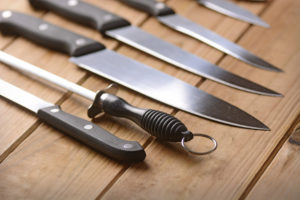
Sharpening Kitchen Knives (Straight Edge)
Kitchen knives are very easy to sharpen, which is fortunate because most of them are left rattling around in drawers or abused in a variety of ways that dulls them very quickly. However, most kitchen-knife users seem to be satisfied with the condition of the knife as long as the cutting edge is keener than the back of the knife. The tolerance for dull knives is amazingly high in most kitchens…
The practical test of sharpness for a kitchen knife is whether or not it will slice soft vegetables, meat or bread. In all three uses, you do not want a knife with a classically sharp edge; you want a slightly serrated edge, a sort of combination between a knife and a saw…
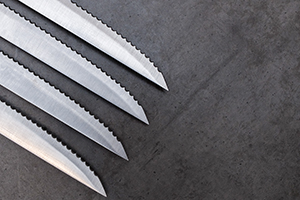
Sharpening Serrated Knives
Serrated knives tend to hold their edge longer than straight-edged knives, and are more difficult to restore without changing their shape. For these reasons, it’s best to sharpen your serrated knives only when you notice them becoming less effective. That said, if you’re willing to put in the labor, a cheap handheld tool will do the job…
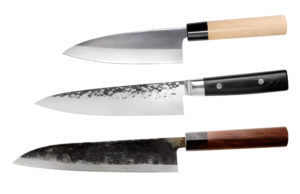
Sharping Japanese Knives
There are a number of laminated Japanese kitchen knives on the market today. Like Japanese chisels, these usually have high-carbon steel laminated to a piece of stainless steel or between two pieces of stainless steel. And like most Japanese tools, Japanese knives require a level of care and respect that most Westerners are unprepared to give such an inanimate device.
Japanese knives will take a very fine edge an can cut paper-thin slices of meat or vegetables. One of the difficulties with them is that the high-carbon steel is very brittle and the knives should generally not be used for chopping of any kind. The edges chip too readily…
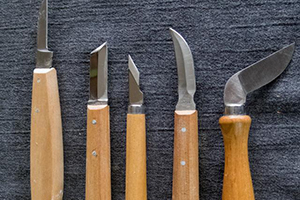
Sharpening Chip Knives
Chip knives are included here because their edge shape is more similar to knives than to the general line of carving tools. Of some ten different kinds of chip knives commonly available, about half are actually chisels rather than knives—relatively small chisels, but chisels nonetheless. The bevels on these can be treated exactly the same way you would treat the bevels on a chisel, leaving them straight and intersecting at whatever chosen angle you desire…
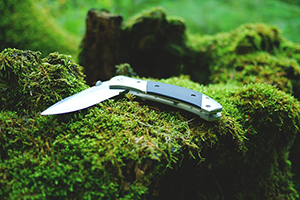
Sharpening Outdoor Knives
SHARPAL BUDDYGUARD sharpener is an advanced tool designed for both seasoned adventurers and casual campers. Its full tang stainless steel body is coated with monocrystalline diamonds, ensuring a durable and long-lasting sharpening surface. With a dual-grit design featuring a coarse 325 grit and an extra fine 1200 grit, this sharpener is capable of both reshaping a dull blade and refining it to a razor-sharp edge.
Preparation: No lubrication is required, which……
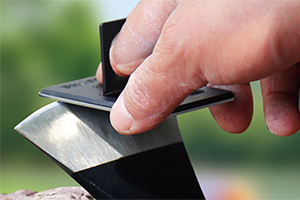
Sharpening Axes
There are two basic types of ax: those with a centered cutting edge (the most common kind), and those where the blade has a single bevel and the cutting edge is not on the central axis of the head (side axes).
The article mainly talks about the centered-edge type. There are three basic shapes—one for felling or general shaping, one for splitting and, most ubiquitous of all, the utility ax. Describing how to sharpen a utility ax. Describing how to sharpen a utility ax is a bit like describing how to sharpen a handsaw for both crosscutting and ripping; it is hardly worth the effort. The tool becomes such a mass of compromises that it performs no single function well…
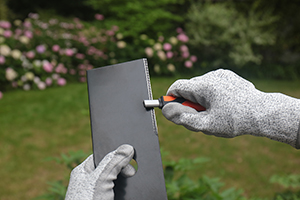
Sharpening Mower Blades
There are few different ways to sharpen lawnmower blades, including using a bench grinder, hand file, rotary tool, or angle grinder. But here’s a quicker, easier and more accurate method: use a drill and sharpening stone that’s specifically designed for putting a cutting edge back onto dull lawnmower blades.
The following instructions explain how to remove the blade prior to sharpening. But, depending on the design of your mower, you might be able to sharpen the blade without removing it, which will save a considerable amount of time. However, taking the blade off allows greater access to the cutting edges and permits better visual inspection of any damage to the blade, such as stress fractures or excessive wear…
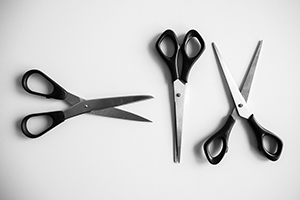
Sharpening Scissors
Over time and with consistent use, all scissors will eventually dull and loose the sharp edges they once possessed when you first bought them. If you are having trouble cutting with dull scissors, you might consider going out and buying another pair, since scissors are relatively inexpensive. However, there are several ways you can sharpen your scissors at home that only require a few common household items, and a little bit of practice.
Top-quality scissors and shears should be sharpened professionally; sewing centers frequently provide the service. But for the under $10 variety, the kind most of us have in our shops, there is no reason not to have a go at them. With a bit of care, you can do a perfectly serviceable job…



